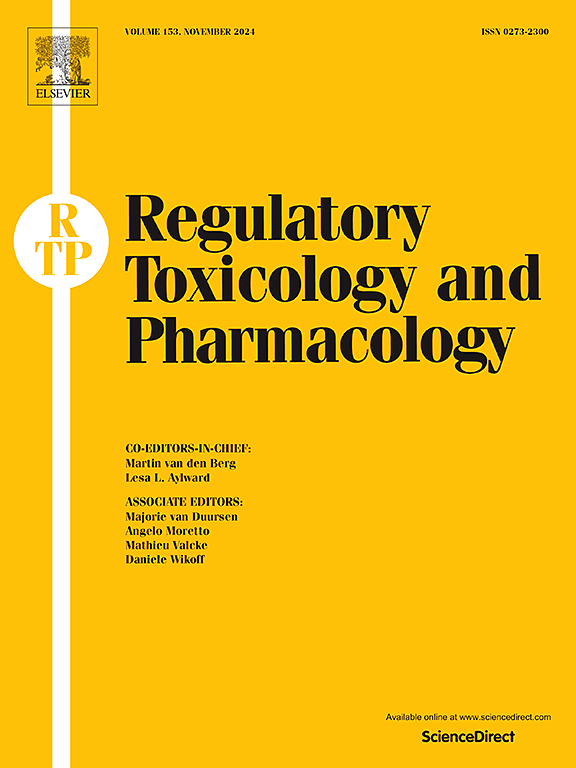利用二维和三维HepaRG细胞评价十种亚硝胺类药物相关杂质的遗传毒性。
IF 3.5
4区 医学
Q1 MEDICINE, LEGAL
引用次数: 0
摘要
亚硝胺类原料药相关杂质(NDSRIs)因其潜在致癌性已成为监管重点。之前,我们使用增强型Ames试验(EAT)和人TK6细胞评估了NDSRIs的诱变性和遗传毒性。在这项研究中,我们使用代谢能力强的人HepaRG细胞研究了10种NDSRIs的遗传毒性。DNA损伤和微核(MN)形成分别在2D和3D模型中使用CometChip和基于流式细胞术的MN测定进行评估。暴露24小时后,5种at阳性NDSRIs (n -亚硝基度洛西汀、n -亚硝基氟西汀、n -亚硝基氯卡色林、n -亚硝基去甲替林和n -亚硝基伐尼克林)在2D和3D模型中均显著诱导DNA损伤,MN和γH2A升高。三维球体中的X地层。在二维培养中,只有三种pet阳性的NDSRIs, n -亚硝基度洛西汀,n -亚硝基氟西汀和n -亚硝基去甲替林增加了MN的频率。在两种模型中,n -亚硝基-双氯芬酸、n -亚硝基-叶酸、n -亚硝基-帕罗西汀、n -亚硝基-地缬草-缬沙坦甲酯和n -亚硝基-地缬草-缬沙坦甲酯均未显示DNA损伤和MN形成。定量比较表明,n -亚硝基去甲替林对HepaRG细胞的基因毒性最强。总体而言,10种NDSRIs在EAT和3D HepaRG球体中表现出相同的阳性/阴性遗传毒性结果。这些发现支持使用3D HepaRG球体作为检测NDSRI诱导的遗传毒性和确认NDSRI在EAT中的反应的另一种体外模型。本文章由计算机程序翻译,如有差异,请以英文原文为准。
Genotoxicity evaluation of ten nitrosamine drug substance-related impurities using 2D and 3D HepaRG cell models
The evaluation of nitrosamine drug substance-related impurities (NDSRIs) has become a regulatory priority due to potential carcinogenicity. Previously, we evaluated mutagenicity and genotoxicity of NDSRIs using the enhanced Ames Test (EAT) and human TK6 cells. In this study, we investigated the genotoxicity of ten of these NDSRIs using metabolically competent human HepaRG cells. DNA damage and micronucleus (MN) formation were evaluated in both 2D and 3D models using the CometChip and flow-cytometry-based MN assays, respectively. After 24-h exposure, five EAT-positive NDSRIs, N-nitroso-duloxetine, N-nitroso-fluoxetine, N-nitroso-lorcaserin, N-nitroso-nortriptyline, and N-nitroso-varenicline, significantly induced DNA damage in both 2D and 3D models and increased MN and γH2A.X formation in 3D spheroids. Only three EAT-positive NDSRIs, N-nitroso-duloxetine, N-nitroso-fluoxetine, and N-nitroso-nortriptyline, increased MN frequency in 2D cultures. The five EAT-negative NDSRIs, N-nitroso-diclofenac, N-nitroso-folic acid, N-nitroso-paroxetine, N-nitroso-desvaleryl-valsartan, and N-nitroso-desvaleryl-valsartan methyl ester, showed no DNA damage or MN formation in either model. Quantitative comparisons showed that N-nitroso-nortriptyline was the most potent genotoxicant in HepaRG cells. Overall, the ten NDSRIs exhibited the same positive/negative genotoxicity outcomes in both the EAT and 3D HepaRG spheroids. These findings support the use of 3D HepaRG spheroids as an alternative in vitro model for detecting NDSRI-induced genotoxicity and confirming NDSRI responses in the EAT.
求助全文
通过发布文献求助,成功后即可免费获取论文全文。
去求助
来源期刊
CiteScore
6.70
自引率
8.80%
发文量
147
审稿时长
58 days
期刊介绍:
Regulatory Toxicology and Pharmacology publishes peer reviewed articles that involve the generation, evaluation, and interpretation of experimental animal and human data that are of direct importance and relevance for regulatory authorities with respect to toxicological and pharmacological regulations in society. All peer-reviewed articles that are published should be devoted to improve the protection of human health and environment. Reviews and discussions are welcomed that address legal and/or regulatory decisions with respect to risk assessment and management of toxicological and pharmacological compounds on a scientific basis. It addresses an international readership of scientists, risk assessors and managers, and other professionals active in the field of human and environmental health.
Types of peer-reviewed articles published:
-Original research articles of relevance for regulatory aspects covering aspects including, but not limited to:
1.Factors influencing human sensitivity
2.Exposure science related to risk assessment
3.Alternative toxicological test methods
4.Frameworks for evaluation and integration of data in regulatory evaluations
5.Harmonization across regulatory agencies
6.Read-across methods and evaluations
-Contemporary Reviews on policy related Research issues
-Letters to the Editor
-Guest Editorials (by Invitation)

 求助内容:
求助内容: 应助结果提醒方式:
应助结果提醒方式:


